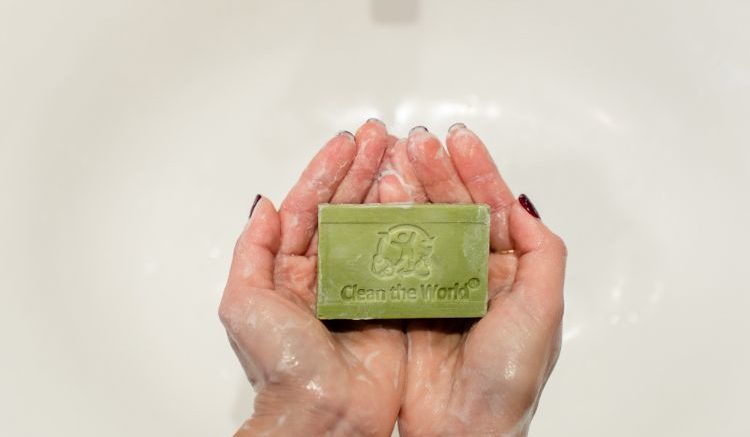I remember as a child, my whole family used the same bar of soap. Gradually though the bar of soap seemed to disappear and was replaced by liquid hand and body wash. Using bar soap had come to be considered unhygienic and a source of bacteria. The strange thing is even though we shared soap, we seldom got sick and had no diseases. In the last decade, I’ve switched back to bar soap again and am still reasonably healthy. So I am just incredibly lucky or have makers of personal care products been masterfully manipulating of our fear of germs?
記得小時候,我們全家都在使用同一塊條狀香皂。漸漸地,條狀香皂似乎消失了,取而代之的是液態香皂,而使用條狀香皂已被認為是不衛生的並且是細菌的來源。奇怪的是,即使我們分享使用同一塊條狀香皂但卻很少生病,也沒有其他疾病。在過去十年中,我再次轉回使用條狀香皂,身體仍然相當健康,這是因為我非常幸運?或者其實是個人護理產品的製造商巧妙地操縱著我們對細菌的恐懼?
The switch from bar soap to liquid has been driven by a fear of bacteria lurking on bar soap. Companies encouraged the notion that using liquid soap was more hygienic.
從條狀香皂轉用到液態香皂的過程,是由於大眾害怕有機會潛伏在條狀香皂上的細菌而引起的影響,同時個人護理產品製造商亦在推廣使用液態香皂更衛生的觀念。
This NY Times article which asked “does each member of the family need an individual bar of soap to prevent spreading germs, or do we have to switch to liquid soap?” came to a very different conclusion. It cites studies that concluded washing even with contaminated bar soap is unlikely to transfer bacteria, especially if the bar gets rinsed off between uses.
這篇紐約時報的文章提出一個議題「是否每個家庭成員需要分別使用個人獨立的條狀香皂來防止細菌傳播?或者我們是否必須改用液態香皂?」這得出了一個非常獨到的結論。它引用的研究說明,即使用被污染了的條狀香皂來洗滌也不太可能轉移菌,特別是如果條狀香皂在使用之間能夠被沖洗掉的話。
According to the NY Times:
“… soap bars were inoculated with E. coli and P. aeruginosa bacteria at levels 70 times as high as those reported on used soap bars. Then, 16 people were told to wash their hands as usual with the inoculated bars.
據“紐約時報”報導:“……條狀香皂被接種大腸桿菌和銅綠假單胞菌,其濃度是使用過的條狀香皂的70倍。然後,16名小組成員像往常一樣用條狀香皂來洗手。
“After washing, none of the 16 panelists had detectable levels of either test bacterium on their hands,” the researchers wrote. “These findings, along with other published reports, show that little hazard exists in routine handwashing with previously used soap bars and support the frequent use of soap and water for handwashing.”
研究報告寫道:“洗滌後,16名小組成員中沒有一人手上有任何可檢測水平的試驗細菌。” “這些研究結果以及其他已發表的報告顯示,在使用已經使用過的條狀香皂進行常規洗手時幾乎沒有危險,並支持經常使用條狀香皂和水進行洗手。”
So how can a bar of soap have bacteria on it and yet not spread germs? Simply, washing is a two step process. When you lather up the oil attracting end of the soap molecule picks up grease and oils on your skin. When you rinse, the water attracting end of the molecules follow the water, letting you rinse the soap molecules — and their attached impurities — away.
那麼一塊條狀香皂怎麼會帶有細菌而又不會傳播細菌呢?簡單地說,洗滌是一個兩步過程。當你洗滌時,泡沫吸收皂分子的末端,會吸收皮膚上的油脂和油份。當你沖洗時,吸引分子末端的水跟隨水流,讓你沖洗皂分子及其附著的雜質 。
This leads us to the next question “if liquid soaps provide no hygiene benefit, why have companies been so aggressive in marketing liquid body washes?”
這引出了我們下一個問題“如果液態香皂沒有提供衛生益處,為什麼製造商在推銷液態沐浴露方面如此積極?”
This article on US website DailyFinance may provide a clue. Their comparison showed bathing with the recommendedamount (2 teaspoons) of Olay body wash cost HK$1.33 per wash while bathing with Ivory bar soap cost just over HK$0.09, providing a significant profit motive for companies to get us to switch.
美國網站DailyFinance上的這篇文章可能提供了一個線索。他們的比較顯示,使用推薦量(2茶匙)的玉蘭油沐浴露每次沖洗花費1.33港元,而使用條狀香皂沐浴時花費僅為0.09港元,這正為製造商提供了重要的利潤動機。
Another often cited advantage of liquid body wash is that it allows manufacturers to add moisturizers. While a complaint against bar soap is that it may be harsh and drying. In fact, there are many varieties of bar soaps in the market that contain glycerine and natural oils that moisturize the skin. These soap can be just as gentle and mild on the skin, negating any advantage of body washes. If body washes have no advantages, do they have any disadvantages? It turns out there are many.
液態沐浴露的另一個經常被引用的優點是它允許製造商添加保濕劑。大眾一般對條狀香皂的投訴是它可能引起刺激和乾燥。事實上,市面上有許多種類的條狀香皂含有甘油和天然油脂,能夠滋潤肌膚,在皮膚上同樣溫和,可以媲美沐浴露的優點。而如果沐浴露沒有任何好處,那麼它有其他缺點嗎?事實證明有很多。
Containing lots of water, body washes are also much heavier than bar soap, resulting in a significantly higher carbon footprint for transportation. Packaging for body washes are made of plastic that ends up in the landfill or our oceans (see picture below). Bar soap has a clear edge in transportation, packaging and disposal.
含有大量水分的沐浴露比起條狀香皂的重量重得多,導致運輸的碳足跡顯著增加。用於沐浴露的包裝由塑料製成,最終廢物會進入垃圾堆填區或我們的海洋(見下圖)。而條狀香皂在運輸,包裝和處理各方面圴具有明顯的優勢。
Lastly, lets take a look at what’s inside. Most liquid body washes are made of petroleum, while many traditional bar soaps are made of saponified animal fat and plant oils. Liquid soaps need the addition of emulsifying agents and stabilizers to maintain their consistency. Although these chemicals may have been approved by the relevant authorities for use on humans, the testing procedures do not include the consequence of long term use or interactions between these and the myriad of other chemicals in our environment.
最後,讓我們來看看兩者裡面的成份,大多數液態沐浴露是由石油製成的,而傳統的條狀香皂多是由皂化動物脂肪和植物油製成。液態香皂需要添加乳化劑和穩定劑以保持其稠度,雖然這些化學品可能已被有關當局批准用於人類,但測試程序不包括長期使用或這些化學品與我們環境中無數其他化學品之間有可能產生相互作用的後果。
For example, diethanolamine (DEA) is commonly added to confer a creamy texture and foaming action. It inhibits in baby mice the absorption of choline (not to be confused with chlorine), which is an essential nutrient necessary for brain development and maintenance. High concentrations of DEA were also found to induce body and organ weight changes, and mild blood, liver, kidney and testicular systemic toxicity in mice. A 2009 study also found that DEA is potentially toxic for aquatic species.
例如,通常加入二乙醇胺(DEA)以賦予乳脂質地和發泡作用。它抑制了小鼠膽鹼的吸收(不要與氯混淆),這是大腦發育和維持所需要的重要營養素。結果還發現高濃度的DEA誘導小鼠體重和器官重量變化,以及對輕度血液,肝臟,腎臟和睾丸引發的毒性。 2009年的一項研究更發現,DEA對水生物種具有潛在毒性。
I can only conclude then that liquid body washes really provide little or no benefits to the consumer, create significant profits for manufacturers, and are tremendously harmful to the environment. So are you ready to switch back?
我只能得出以下結論,液態沐浴露給消費者帶來了極少、甚至沒有好處,它為製造商創造了巨大的利潤,但對環境有極大的危害。所以你準備好轉回使用條狀香皂嗎?
Written by Fai Hui from Go Green Hong Kong. You can read the original article HERE
由Go Green Hong Kong的 Fai Hui 撰寫。請按此閱讀原文

